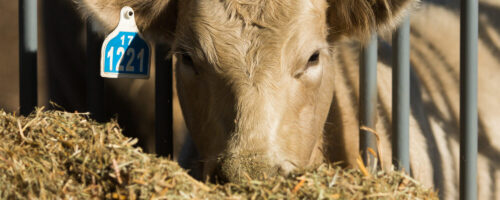Cattails – Habitat or Hassle
Cattails can be desirable or undesirable, depending upon a pond or marsh manager's goals.
Cattails, Typha spp., are common emergent aquatic plants. They are native perennials that grow in moist soil and are adapted to water depths up to 2.5 feet. Two species of cattails occur in south central Oklahoma and north central Texas.
Cattails can be desirable or undesirable, depending upon a pond or marsh manager’s goals. They provide nesting habitat for blackbirds and some duck species, as well as brood rearing cover and feeding substrate for ducks and fish. They help prevent erosion of dams and pond banks. Stands of cattails provide natural blinds for duck hunters and bird watchers.
For those interested in native foods, several parts of the plants are edible. The corms and young greenish shoots attached to the rhizomes can be collected during fall, winter, and early spring. The corms and shoots can be eaten raw or cooked as vegetables. The shoots should be collected before they are two feet tall and peeled before eating. The immature green spikes can be collected during late spring and peeled, boiled, and served like corn on the cob. Immediately after the staminate (male) spikes ripen, yellow pollen can be collected, sifted, dried, and mixed with other flour for food such as pancakes and muffins. From late fall through early spring, the inner part of the rhizomes can provide gluten-rich flour. This flour is generally obtained by peeling the rhizomes, breaking them apart underwater, washing the flour from the fibers, straining the fibers from the flour, washing the flour again, and then pouring off the water. The wet flour can be used immediately or dried and then stored.
The cottonlike down collected from ripe pistillate (female) spikes has been used for flotation in life rafts and life preservers. The long basal leaves are used for making rush seating in chairs. The by-products from processing cattails can be fed to livestock or used as mulch. The spring growth provides fair cattle forage.
Yet, with their many potential benefits, cattails frequently become pests. In shallow impoundments, they can dominate plant communities, reducing plant diversity and habitat for other organisms. They can hinder fishing, swimming, and boating. They can impede water flow through irrigation or drainage channels. They can interfere with fish harvests in aquaculture facilities. Extensive stands of cattails accelerate the eutrophication of impoundments, which is a process of aging, nutrient enrichment, and sedimentation.
Cattails spread very quickly. A few cattails are easier to control than many, so prompt action is warranted when a pond or marsh manager’s goals dictate that cattails should be controlled or managed. There are many tools available for the job, including increasing water depth, cutting, crushing, grazing, stocking grass carp, or spraying herbicides.
“An ounce of prevention is worth a pound of cure.” To prevent cattails from dominating an impoundment, design or excavate most of it deeper than 3.5 feet during construction. Shallow areas of existing impoundments can be excavated with backhoes, track hoes, or other machines to minimize the areas where cattails can grow. Sometimes the height of dams or water control structures can be raised to increase water depths. However, impoundment manipulations that occur after initial construction tend to be relatively expensive.
Seedling cattails can be killed by simply pulling them up before they establish rhizomes. Established cattails can be killed by repeated cutting, crushing, or grazing (several times a year), which depletes their energy reserves as they try to regrow and basically starves them to death. Generally, the latter approach also involves drawdowns to facilitate the cutting, crushing, or grazing. These treatments usually harm other emergent aquatic and shoreline plants in the vicinity of the treatments.
Large grass carp, typically those over 10 pounds, control cattails in many impoundments. However in some impoundments, they seem to impact cattails relatively little. Generally, at least ten grass carp per surface acre are stocked to control submerged aquatic plants. When the grass carp eliminate the submerged aquatic plants and grow large enough, they often consume coarse emergent aquatic plants such as cattails. However, such extensive removal of aquatic plants often causes water quality, wildlife habitat, and fish habitat to deteriorate.
Several herbicides are labeled for treating cattails, including glyphosate (Rodeo and Glypro), diquat dibromide (Reward), and fluridone (Sonar). When I decide that a herbicide is my best control or management option, I usually choose glyphosate to control cattails, considering relative effectiveness, cost, risk to nontarget species, and use restrictions. A nonionic surfactant should be mixed in solution with glyphosate herbicides when cattails are treated. Please always read and follow the label when using any herbicide.
To paraphrase Shakespeare, “To control, or not to control: that is the question.”


Comment